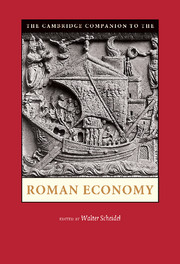1 - Approaching the Roman economy
Published online by Cambridge University Press: 05 February 2013
Summary
Defining the Roman economy
What was the “Roman economy?” In this volume, we apply this term to economic developments that occurred within the Roman Empire, a polity that evolved from an alliance system in peninsular Italy into a large empire that from the second century bce onward came to dominate and then rule the most densely populated parts of western Eurasia and North Africa west of Mesopotamia and Iran before it eventually experienced substantial contraction in the fifth and seventh centuries ce. Although many of the following chapters devote particular attention to conditions in Roman Italy, the original core of the empire, coverage extends across the varied territories under Roman control. More specifically, this volume seeks to relate economic structures and processes to the formation of the imperial state.
Thanks to its exceptional size and duration, the Roman Empire offers one of the best opportunities to study economic development in the context of an agrarian world empire. Moreover, the fact that the Roman period was the only time when the entire Mediterranean basin was contained within a single political domain raises the question of how much the specific characteristics of the Roman economy owed to imperial unification. The Roman economy was a typical pre-modern economy in the sense that it depended on organic fuels and was dominated by agriculture and production within households. In developmental terms, it can be seen as the continuation and culmination of the expansion of the Hellenistic economies of the Eastern Mediterranean and Near East that in turn represented the mature phase of the political and economic recovery that had commenced in the Early Iron Age. The Roman period witnessed the extension of Near Eastern, Hellenic, and Hellenistic features such as urbanization, monetization, market exchange, taxation, and chattel slavery into the western peripheries of Eurasia.
- Type
- Chapter
- Information
- The Cambridge Companion to the Roman Economy , pp. 1 - 22Publisher: Cambridge University PressPrint publication year: 2012
- 5
- Cited by



